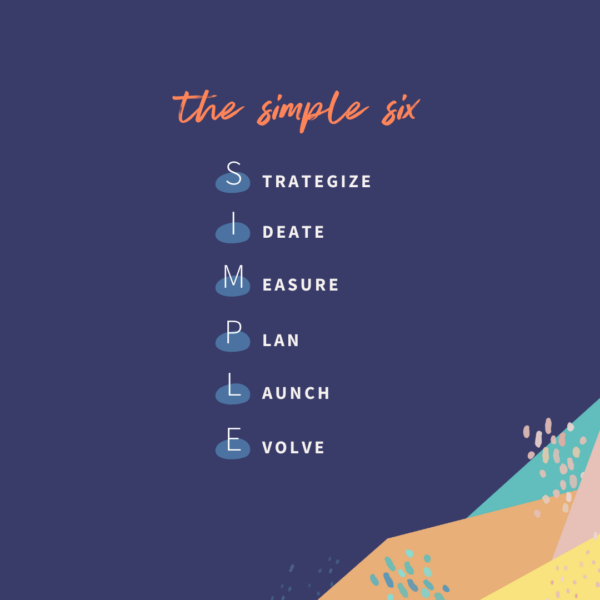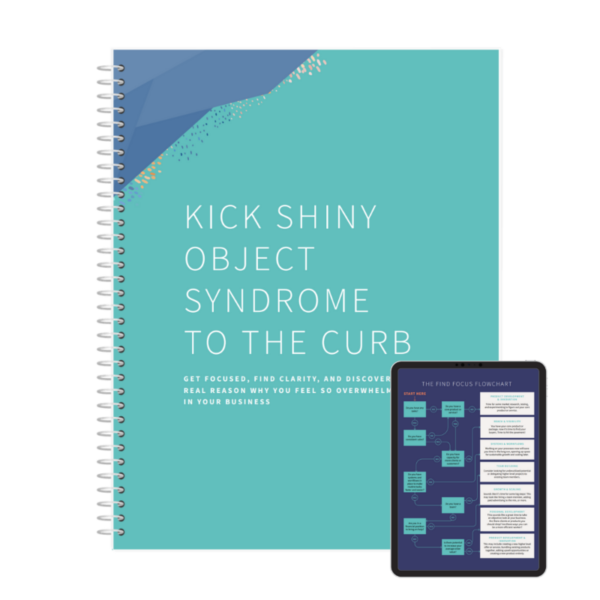The Simple Six: Strategic Launches for Your Small Business
When I entered the online small business and entrepreneurship space, I realized something: Most people who start an online business didn’t go to business school, let alone get their MBA. Some had never worked in a corporate setting, and definitely never used traditional project management frameworks that are a bit more “second nature” in the corporate world.
While these business owners had amazing products or services, they lacked the momentum or direction that larger businesses with their streams of employees and enterprise-level systems had. Don’t get me wrong, having the budget to hire a team to implement your grand ideas would be great—but it’d hardly solve the core problem.
You see, these business owners weren’t left behind just because they didn’t have the resources to hire a bunch of people, it was because they weren’t using the simple frameworks that large companies rely on. These frameworks streamline massive cross-functional projects that span multiple departments— and small businesses can use the same tools to help them decide where to invest their energy and other resources.
If you’re going from chaotic launch to chaotic launch, throwing new ideas and offers into the mix frequently, and wondering why you’re not getting the kind of revenue or growth you want… it could be because your projects lack structure (and probably because you have way too many of them happening at the same time).
Without strategic tools and frameworks to help you make decisions and plan for growth, your business can feel a bit like riding a wild horse with no saddle and no reins.
Let’s slow down that pony and give it some direction. I want to introduce you to the Simple Six.
What is the Simple Six?
The concept of creating strategic pillars is not new if you’re familiar with corporate-level project management. I even share my version of these pillars for online business owners in my free resource, Kick Shiny Object Syndrome to the Curb. When it comes to actually getting things done for your business, though, I want to break it down even further.
Instead of talking about the strategic, high-level areas of your business right now, I want to talk instead about your individual projects. Whether you’re launching a new program, redoing your website, or adding more products to your online shop — each of those is a project and should be managed accordingly.
Odds are, you have a few projects on the burner right now since most online small business owners and entrepreneurs I’ve met usually have a half-dozen running at once. This is when it’s time to apply my Simple Six:
- S trategize
- I deate
- M easure
- P lan
- L aunch
- E volve

Strategize
This is the very first phase of the Simple Six. This is where you decide what your strategic goals are (i.e. launch your new course in March, reach 7 figures in product sales by Q4, etc.). Notice how I didn’t just say “decide what your goals are.” They need to be strategic, as in chosen intentionally, and have a clear purpose.
A strategic goal is not the idea you had in the shower about the opt-in you’d like to create. A strategic goal is planning to grow your email subscribers by 2,000 people this year.
Ideate
Once you know the strategic goals you want to hit, it’s time to generate ideas on how to get there. This is where the opt-in idea you had in the shower comes in, to help you reach your new subscriber strategic goal. During the ideation phase, you brainstorm the offers, products, or campaigns that you can use to help you reach your goals. These are often the specific projects you need to execute.
Measure
Now that you know how you’re reaching your strategic goals (with a specific idea), it’s time to figure out how you’ll know if the idea is a good one. To keep with the example above, how would you know that opt-in is actually helping you reach 2,000 new subscribers?
In this phase, you’ll map out which metrics to monitor, i.e. your new subscriber count, opt-in page views and abandons, etc. You may also want to choose benchmarks or budgets in this phase if you’re using paid ads or have a large marketing push to promote your new offer.
For example, “We will not spend more than $2 per lead on Facebook ads for this opt-in, with a total budget of $2,000.” You can track progress like sales, traffic, ad spend, and more in a simple metrics tracking spreadsheet, or you can access my Metrics & KPI Tracker Template here.
Before you select metrics for a new project, I highly recommend reviewing your basic metrics first: your marketing, your time, your happiness, and your money. I dive deeper into these metrics and how to apply them to your business growth in my FREE metrics email series.
Plan
It’s time to set deadlines and create the runway to launch. You can’t just say,” Create opt-in to attract new subscribers.” You have to break it down into the different phases, from content creation to tech setup to marketing, launching, and delivery. Run through everything you’ll need for this particular project, and assign out due dates that align with your strategic goal’s timeline. (I give a taste of what this process looks like right here.) This is the part that requires special attention if you have a team because there are a number of factors — from the scope of contractor relationships to availability and turnaround time.
Launch!
This is the phase most visionary business owners and entrepreneurs enjoy the most. It’s also the phase they often skip to in the strategic project plan. Don’t do that. That’s how you end up with a wild stallion for a business.
I see so many visionary CEOs skipping the actual product creation part and jumping right into pre-selling it like a lazy Kickstarter campaign. You don’t want to do that, right?
Instead, complete the other 4 steps prior to launch, keeping in mind your strategic goals, metrics, and timelines. When you do launch, you’ll want to keep an eye on all of the metrics you selected in Phase 3, and to ensure you have a proper plan for managing the process. This could include customer support, troubleshooting, and in-the-moment improvements, depending on what you’re launching.
Evolve
There’s another problematic habit I’ve seen in the online space: approaching a launch as a “one-and-done.” Because you didn’t get the hype or sales you wanted from your project’s launch, you assume the product is a dud or that it’s not the right offer for your audience… and you immediately pick up the next idea on your brainstorm list. If large companies did that, they would never grow. You have to evolve your projects and look back through the previous 5 phases of Simple Six after a launch.
You may realize:
- that part of your ideation phase didn’t hit on something people were asking for during your launch (this happens a lot when clients launch courses and people ask for certain modules);
- that your sales page didn’t hit your desired metrics and could use some tweaks;
- that the project runway was too rushed, or a deliverable was too delayed, and that needs to be addressed in the next iteration;
- that your audience takes a bit more time to purchase your offers, so extending the launch runway is key;
- that the way you describe your offer wasn’t in line with the words your customers would use;
- or maybe you simply need to build more trust with your audience before they want to buy from you.
Once you finish the launch cycle and assess everything to see how you can evolve… the Simple Six framework starts over. You’ll want to apply this framework to each of your projects, including projects you’re repeating (like a course launch, mastermind push, etc.).
Rinse, strategize, repeat
This framework is simple for a reason: Because your business’s projects don’t have to be complicated. You don’t have to follow an 81-step launch plan that doesn’t align with your strategic goals, and you don’t have to track metrics that actually muddy impressions of how your new offer or campaign worked.
Do the work to strategize, ideate, measure, and plan your launches before they’re underway… and you will realize that your launches have much more impact (and likely drive more revenue).
Be intentional with the projects you choose, too, and focus on projects in areas of strategic success. If you aren’t sure what those are, I definitely recommend accessing my strategic pillars resource to ensure you’re using your time, money, and energy in ways that matter.

Be the first to comment